La Om was tough, but wonderful! Thanks for getting me to the finish line!
George G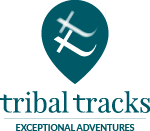
Location
Terrain
Difficulty
Accommodation and Meals
Hotel, Guesthouse
Duration
5 days
Meeting Point
Brasov
Annual Leave
3 days
Group Size
Up to 16
Seasons
June to September
Walking Distance
41km
Meet Charlie, a director of, and one of the co-founders of Tribal Tracks.
If you are short on time, this trek really packs a bang for its buck. Summiting 5 peaks in 3 days is an incredible achievement and there is no need to camp!
Travel the path less travelled to a remote and wild part of Europe.
Experience Romanian hospitality, culture and cuisine, staying in family run village guesthouses in beautiful locations.
All the info you need
Trip Details
This demanding, three day trek takes you to this wonderful landscape, where we tackle five different peaks; Omu (2505m), Oculit (2503m), Bucks Fang (2168m), Batrana (2181m) and La Om (2238m).
Our challenge takes us first into the rugged Bucegi mountains, one of Romania’s best-kept secrets. With glacial lakes, alpine grasslands and vast, ancient woodlands, these mountains are also home to some of Europe’s most elusive mammals; brown bear, wolves, lynx and bison as well as Golden Eagles and the elusive Ural Owl. We then head to the Piatra Crailui mountain range, characterised by its dramatic limestone ridge rising sharply from the forests and plains below.
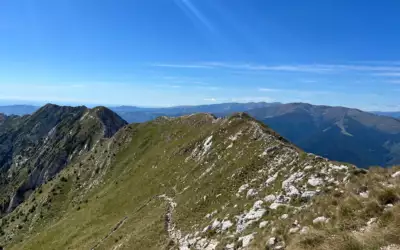
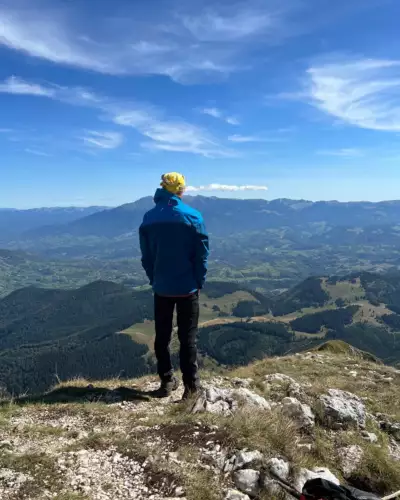
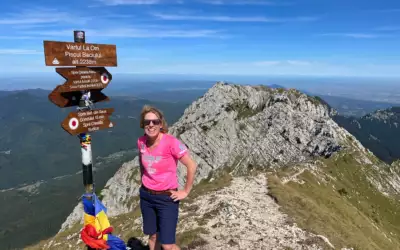
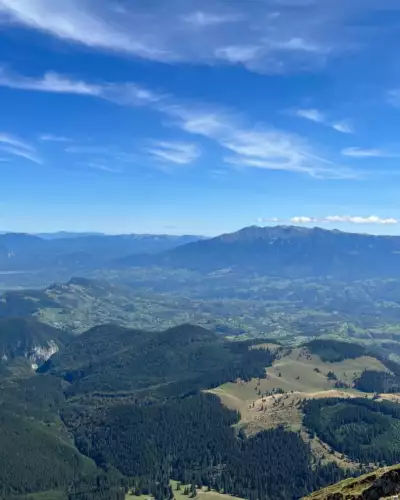
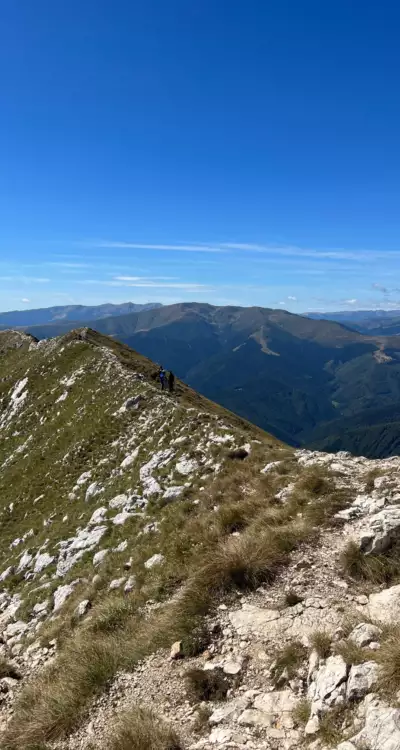
Trip Details
After meeting your Tribal Tracks group leader at the airport, we fly from London to Brasov where we will be welcomed by our Romanian team.
We head north to the mountain village of Gira Diham, a secluded village surrounded by thick forest, this is the starting point of our epic 5 peak challenge. We will have a team briefing and kit check before dinner.
Accommodation and Meals
Overnight Gira Diham Guesthouse. Dinner.
Our adventure begins after breakfast.
We leave from our guesthouse straight into the Cerbului Valley forest and head up into the Bucegi Mountain range. These mountains are on the Eastern border of Southern Carpathians and are the second highest group of mountains in the Carpathian Mountain range, with the mountains reaching heights of over 2500m.
Following the Cerbului Valley (the Valley of the Deer) under the forest canopy, we make our ascent towards our first summit, Omu Peak (2505m); this is the highest point in the Bucegi Massif and has impressive views. We remain above 2000m and continue along the ridge towards to our second peak, Oculit. After lunch we descend to Padina village via the Ialomita Valley, passing sheepfolds, several springs and beautiful waterfalls. Two down, four to go!
Accommodation and Meals
Overnight in Padina Village. Full board.
This morning, we leave the Iamolita Valley and trek towards our next two summits, Bucks Fang (2168m) and Batrana (2181m).
It is a steady ascent through the traditional farmlands where we can hear the cattle bells echoing through the valley. We follow the former border guards’ path which is a steep and steady climb towards Strunga Ridge. At the top of the ridge, we are rewarded with wonderful views across the entire Tara Branului (Bran County) and Piatra Craiului Massif. Following the ridge line we head towards Bucks Fang, this peak is marked with a large prominent cross. After a short break we continue along the ridgeline to Batrana Peak before we head to the red and white domed shaped refuge for lunch.
We have a long descent into the Bangaleasa Valley; the route is a steep and we will need to take care. As we approach the Gutana meadow fields, the route levels out and we complete the final phase of the route into Moieciu de Sus village. We will have a short transfer to our guesthouse where we will spend the night. One more summit to go!
Accommodation and Meals
Guesthouse in Moieciu de Sus village. Full board.
Today is our final summit and is a fitting challenge. La Om (2238m) is not the highest peak that we will summit, but it is the hardest.
We start our trek on the Northern Ridge of the Piatra Craiului Mountains, our second mountain range. We take a short transfer to the start of our trek starting just outside Pestera Village. We navigate our way through the thick forest and continue to ascend towards the mountain refuge at the base of La Om, where we can rest before the tough climb to the summit. The route from the refuge to the summit is uneven and steep, and we will need to concentrate on our footing as we head to the summit. At the summit, we are rewarded with incredible views of the Carpathian mountains.
Taking a little time to reflect on our five peak achievement, we carefully descend, retracing our steps towards to mountain hut and back to Pestera village for a well-earned rest and final celebration.
Accommodation and Meals
Guesthouse in Moieciu de Sus village. Full board.
Trip Details

Trip Details
In a nutshell, almost everything!
This is what you will need to buy/source yourself.
It is important that you read the itinerary carefully, and take account of the rating we have given it.
Although our challenges are not technical, they do require a good degree of physical fitness. The conditions will require stamina and strength, which you should recognise and train for. This will be a much better experience if you are fit and prepared. You should feel comfortable walking 6-8 hours per day.
In setting the maximum size of our groups, we take a number of factors into account.
Altitude, degree of difficulty, the terrain, the climate and time of year, all determine the maximum group size. Sometimes it will be 20, sometimes it will be 8-14, but safety is always our priority.
You will be accompanied by a Tribal Tracks UK Leader, Mountain Leader qualified, as well as supported by our local, in-country guides.
It is a requirement of Tribal Tracks booking terms and conditions that each supporter must hold their own travel insurance, which covers the trip and the activities they are doing. Read more here.
We advise you to put insurance in place as soon as possible, ideally on booking so you are covered immediately. Your insurance must be valid and in date, covering the entire period that you are travelling for, including the return journey home. It should cover medical and personal accident risks, and should include repatriation costs and air ambulance or helicopter rescue services, where appropriate.
Tribal Tracks has 100% Financial Protection and has a trust account with the Protected Trust Service, member number 5566.
This means that all client monies paid to Tribal Tracks are held in our dedicated trust account, which is supervised by an independent trustee. This means that in the very unlikely event that Tribal Tracks ceases to trade, your money is safe. For more information, please visit this link. Any flights booked for you by Tribal Tracks will be ATOL-protected under our own ATOL certificate.
Tribal Tracks considers the safety of all of its participants and staff to be a top priority, and as such we have thorough safety systems in place.
In the event of an injury, we have an evacuation plan in place for all elements of the trek route. We do ask that you look after yourself during the trek in the following way, as this will help avoid unnecessary problems:
We know that the unexpected can happen.
While you are away, things can happen at home and people may need to get in contact with you. This can be tricky when you are in remote areas. So, shortly before departure, we provide you with an Emergency Procedure document to distribute to your nearest and dearest. This sets out how to contact Tribal Tracks and the steps Tribal Tracks will then take to get in contact with you.
It is really important that you are well prepared for your physical challenge and that you are confident that you will be able to fully participate.
Although our leaders are well trained to deal with different capabilities, if they have any concerns about someone’s ability to safely partake in the trek, or their impact on other people’s enjoyment, we authorise them to take necessary action which, in some circumstances, may involve asking someone to step out of the trek. Although this is a very rare occurrence, by booking this trip you agree to section 11 of our Booking Conditions which clearly states that our leaders have the authority to do this. In these circumstances, we will ensure anyone sitting out is safely provided for and offered alternative options where possible. Refunds will not be provided for activities missed and customers may be liable for additional costs incurred.
At Tribal Tracks, Responsible Travel is enormously important to us, and our commitment to responsible travel is evidenced in every itinerary that we prepare.
Core to our business is the belief that holidays can and should be enjoyable to the traveller but should be conducted in a socially, environmentally and economically responsible manner which brings benefit to local communities. This is implemented through a variety of measures which can be found in our Responsible Travel policy. We encourage you to read this and to play your own part in travelling responsibly.
In a nutshell, almost everything!
This is what you will need to pay for/ buy/source yourself.
Trip Details
Trip Details
The trek is a challenge. We will be walking for a long time over sometimes challenging terrain with steep ascents and descents.
The best way to build endurance fitness is to start with some gentle walks and gradually build up both the distance and duration over the next few months. In the last 2 months, we would recommend to go out and do long days, ideally in the hills, to build up the strength in your legs. About a week before the trek, limit any training to short walks – you want to have fresh legs at the start!
For the trek you should be comfortable trekking between 6 - 8 hours per day, but remember we have all day to achieve the distances and will not be going at racing snake pace. It may sound obvious, but make sure that you are walking properly, hitting the ground with your heel first, then rolling onto your toe, which pushes you onto the next step (this will help reduce the risk of shin splints and tendon pulls). Walk with your head up, eyes forward and shoulders level.
It is a good idea to develop a level of cardiovascular fitness (exercising and strengthening your heart and lungs). This comes from running, cycling or swimming for between 20 minutes and an hour, and will really help develop your endurance fitness. Three sessions a week is normally advised, increasing time and distance over time.
Replicate conditions in training i.e., use all the kit you will be using and try your walking poles if you want to use them.
It is important to pack so that you know where everything is. Separating kit into different packing cubes, or even plastic bags can really help with this. You can pack by item (eg socks and pants in one cube, tops in another etc) or by day, putting your entire outfit for that day together in one place. Taking an extra bag or cube to separate dirty kit is a great idea.
You will have two bags on the trip - your main bag and your back pack.
You should operate on the basis that you will not have access to your main bag during the day and while you are trekking. This means that it is important to have everything you need in your back pack. Waterproofs should go in the bottom, together with an extra layer, sunscreen and sunglasses, plus hat and gloves (if you are in a colder climate). You should also have your water bottles, and any specific snacks, medicines or first aid items you want to take, such as zinc tape and blister plasters. Baby wipes/toilet roll and nappy sacks are also essential for going to the toilet while you are trekking - we will explain more in the pre-departure briefing!
In the event of an injury, we have an evacuation plan in place for all elements of the trek route. We do ask that you look after yourself during the trek in the following way, as this will help avoid unnecessary problems:
We will brief you in the pre-departure briefing as to the catering specifically for your trip. However, as a guide, each morning you will be provided with a very filling local breakfast, usually accompanied by tea or coffee. Lunch will be during your trek and will be prepared by the team of cooks or we will utilise local restaurants or teahouses. Food will always be ample and tasty. If wild camping, dinner will be in the dining tent and will be traditional, freshly prepared food. If you are staying in a hotel or teahouse, dinner will be served there. Water, tea and coffee will be served and alcohol will usually not be available, although there will be some exceptions. We will provide 4 litres of drinking water per person per day. You will need to fill up 2 litres at breakfast and another 2 litres at lunchtime.
Please ensure that you have notified us before departure if you have any specific dietary requirements or allergies as we can cater for most.
Please inform us of any dietary requirements or allergies before you travel, and preferably at the time of booking. We can cater for almost all diets, but only if we know about them beforehand.
You will sleep in shared tents (unless a single supplement has been requested). Mattresses are provided, which makes it much more comfortable! There will be a central dining tent available with rugs and lights where the group can get together in the evening, share stories and enjoy meals. There will also be an open fire wherever it is possible.
Sleeping bags are designed to work by trapping your body heat in the down surrounding you. If you wear lots of layers, your body heat will not be able to escape as effectively, and you will be cold. Wearing a thin thermal layer is ideal. It does sound counter intuitive, but we promise that it works!
Putting your clothes for the next day in the bottom of your sleeping bag will also help with warmth, as it will fill up any spare space around your feet, and it will mean your clothes are nicely warmed up in the morning.
If you find it difficult to sleep without a pillow, we recommend that you take a travel pillow and a regular pillowcase with you. Put your pillow in the pillow case, and use your down jacket/layers to fill out the pillowcase, you will end up with a pretty decent pillow!
And as for stuff or roll when it comes to packing your bag away? We are very much in the stuff camp! Read more here.
There will be early morning starts, typically around 0600 - 0700hrs, so that the team can set off on the trek in good time. It is important that you pack up your kit before breakfast and leave your bag outside your tent or accommodation so that the crew can load them onto the jeeps and/or mules. There will be a freshly cooked lunch provided on your trek route. The aim is to get into camp before sunset if possible, when you can enjoy a hot drink and snacks. It is important that you change into your thermals and put layers on when you get into camp as the temperatures can drop sharply and you need to keep warm.
In the morning, the Tribal Tracks leader will wake up the group. When you hear the call, please begin to get ready, and pack all your kit away in your 'main bag' before breakfast. Put this bag outside your tent or accommodation as the crew can then begin to break down the tents/load the luggage. Ensure that you have all that you need in your backpack for the day, as you will not have access to your main bag until the next camp (see 'What do I put in my backpack?).
When you arrive into camp, it is important to get changed into different clothes, usually the ones that you will be wearing the next day. Even if you have had dry weather, you will have been sweating, and your clothes will be damp. As the sun sets and the air cools, you will quickly feel cold. Before this, you will want to freshen up and we recommend the 'baby wipe bath'. As there are no showers while on the trek, having a freshen up with a baby wipe will help keep you clean and will make you feel much better, before you put your clean clothes on. Unpack your sleeping bag and get everything out that you need for nighttime, such as your warm hat, jacket, head torch and book. Sort out your back pack for the next day by removing rubbish and replenishing snacks etc.
Doing this before dinner will mean you can get into your sleeping bag quickly, when it is likely to feel cold.
For up-to-date vaccinations information please visit the NHS website ‘Fit for Travel’ at: http://www.fitfortravel.nhs.uk. The Tribal Tracks team are travel professionals, but we are not medical experts, and we would encourage you to visit your GP or travel nurse to discuss vaccination requirements. Please remember to take your itinerary with you so that they can see where you will be travelling. You should make an appointment at least 3-4 months before you travel.
In addition, please note that information on vaccinations can change at short notice; we recommend that you contact your Medical Professional or a Travel Health Clinic at least 8 weeks prior to departure for the most up to date information.
We recommend that you bring a multi-region adapter plug with you. There will be no facility to recharge electrical items on the trek, so we recommend you bring a power bank to top up the charge. We also recommend putting your phone on Airplane mode during the day to save on power.
Using your mobile overseas can sometimes attract unwelcome, very high tariffs. We recommend that you check with your network provider before you travel, but if in doubt, keep your phone switched to Airplane mode and use it only when there is WiFi. Reception can also be patchy, and unreliable, particularly in remote areas, which is why we carry a satellite phone with us. Please let your nearest and dearest know about this, and warn them that you may not be able to be in regular contact.
Trekking at high altitude (generally above 2500 metres) involves additional risk not normally associated with lower level treks. This is not something that should prevent you from undertaking a trek to our higher destinations, but it makes sense to learn about the dangers inherent in trekking at high altitude and also the ‘golden rules' to prevent Acute Mountain Sickness (AMS).
For each of our trips, you can find the maximum altitudes listed on the web site and in the itineraries. You should read the itinerary carefully and use your own judgement to gauge whether your chosen trip is suitable for your level of experience. If you have any doubts at all you should contact us and we are happy to discuss the trip with you.
You can acclimatise to altitude by the process known as acclimatisation. The most important rule is to gain height slowly and it is generally accepted that the maximum safe altitude gain in any one day is 500 metres once above 2500 metres. Where this is not possible, then it is important to have a rest or acclimatisation day at the new altitude before gaining further height. All our itineraries follow this rule. In general the maxim ‘climb high and sleep low' applies. It is perfectly acceptable (and even beneficial to your acclimatisation) to climb higher than 500 metres above your last camp (for example when crossing a high pass) as long as the increase in sleeping altitude remains within the above rule. All of our itineraries are carefully designed to build in optimum acclimatisation.
There is a link between daily fluid intake and successful acclimatisation and you must pay particular attention to hydration during trekking at high altitudes. On treks to 3000 metres and above most people will need to drink between 5 and 6 litres each day to achieve suitable hydration levels and you must adopt a responsible approach to achieving this target. It goes without saying that as alcohol is a diuretic, it is not recommended that you drink alcohol while at altitude.
Before embarking on a trek to high altitude it is important that you familiarise yourself with the signs and symptoms of Acute Mountain Sickness (AMS) and that you report any illness to your tip leader straight away. See the links at the bottom of this page for further reading on AMS.
There are a number of untested herbal remedies which claim to prevent mountain sickness. However, only one drug is currently known to have a useful role in preventing AMS and to be safe for this purpose: acetazolamide (Diamox). We recommend that you carry Diamox in your first aid kit for treks where you spend an extended period above 4000m. Diamox can only be obtained from a medical professional on prescription and it is important that you first consult your own doctor so that you know there are no contra indications with other medicines you may be taking and that you do not have an allergy to acetazolamide. Diamox commonly causes some minor side effects, such as tingling fingers and toes, or a metallic taste in the mouth, but more severe reactions are rare. On trek, the decision whether or not and when, you should take Diamox as with any drug, will rest solely with you. If you intend to take Diamox, you must familiarise yourself with the appropriate dosage and regime prior to coming on the trip. The links at the bottom of this page will provide further information on the use of Diamox as an aid to acclimatisation.
Travelling to high altitudes is not something you need to be scared of. Every year thousands of people enjoy the most amazing experiences in the world's greatest mountain ranges. Altitude sickness is entirely preventable if you follow the very simple rules and procedures detailed above. Please make sure you are aware of these before you travel. However, please be assured that we have emergency procedures in place in the event that someone does experience AMS.
For further reading on the above issues we recommend the following websites:
http://www.altitude.org/altitude_sickness.php
Trip Details
Romania is a wonderful country with so much to explore. If you want to extend your stay after the challenge, please let us know and we can happily arrange a bespoke itinerary for you.
Have a question about Tribal Tracks? Get in touch, our small team will be delighted to help.